Androgen receptor non-nuclear regulation of prostate cancer cell invasion mediated by Src and matriptase
- PMID: 25730905
- PMCID: PMC4466655
- DOI: 10.18632/oncotarget.3119
Androgen receptor non-nuclear regulation of prostate cancer cell invasion mediated by Src and matriptase
Abstract
Castration-resistant prostate cancers still depend on nuclear androgen receptor (AR) function despite their lack of dependence on exogenous androgen. Second generation anti-androgen therapies are more efficient at blocking nuclear AR; however resistant tumors still develop. Recent studies indicate Src is highly active in these resistant tumors. By manipulating AR activity in several different prostate cancer cell lines through RNAi, drug treatment, and the use of a nuclear-deficient AR mutant, we demonstrate that androgen acting on cytoplasmic AR rapidly stimulates Src tyrosine kinase via a non-genomic mechanism. Cytoplasmic AR, acting through Src enhances laminin integrin-dependent invasion. Active Matriptase, which cleaves laminin, is elevated within minutes after androgen stimulation, and is subsequently shed into the medium. Matriptase activation and shedding induced by cytoplasmic AR is dependent on Src. Concomitantly, CDCP1/gp140, a Matriptase and Src substrate that controls integrin-based migration, is activated. However, only inhibition of Matriptase, but not CDCP1, suppresses the AR/Src-dependent increase in invasion. Matriptase, present in conditioned medium from AR-stimulated cells, is sufficient to enhance invasion in the absence of androgen. Thus, invasion is stimulated by a rapid but sustained increase in Src activity, mediated non-genomically by cytoplasmic AR, leading to rapid activation and shedding of the laminin protease Matriptase.
Keywords: Src; castration-resistant; metastasis; nongenomic AR signaling; prostate cancer.
Conflict of interest statement
The authors declare no conflict of interest.
Figures
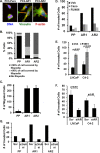
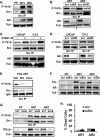
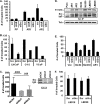
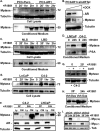
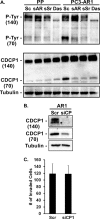

Similar articles
-
Changes in androgen receptor nongenotropic signaling correlate with transition of LNCaP cells to androgen independence.Cancer Res. 2004 Oct 1;64(19):7156-68. doi: 10.1158/0008-5472.CAN-04-1121. Cancer Res. 2004. PMID: 15466214
-
HOXC8 inhibits androgen receptor signaling in human prostate cancer cells by inhibiting SRC-3 recruitment to direct androgen target genes.Mol Cancer Res. 2010 Dec;8(12):1643-55. doi: 10.1158/1541-7786.MCR-10-0111. Epub 2010 Nov 2. Mol Cancer Res. 2010. PMID: 21047772
-
The androgen receptor induces integrin α6β1 to promote prostate tumor cell survival via NF-κB and Bcl-xL Independently of PI3K signaling.Cancer Res. 2011 Apr 1;71(7):2739-49. doi: 10.1158/0008-5472.CAN-10-2745. Epub 2011 Feb 10. Cancer Res. 2011. PMID: 21310825 Free PMC article.
-
Androgen receptors in hormone-dependent and castration-resistant prostate cancer.Pharmacol Ther. 2013 Dec;140(3):223-38. doi: 10.1016/j.pharmthera.2013.07.003. Epub 2013 Jul 13. Pharmacol Ther. 2013. PMID: 23859952 Review.
-
Oncogenic activation of androgen receptor.Urol Oncol. 2009 Jan-Feb;27(1):48-52. doi: 10.1016/j.urolonc.2008.06.002. Urol Oncol. 2009. PMID: 19111798 Free PMC article. Review.
Cited by
-
Prostate-specific markers to identify rare prostate cancer cells in liquid biopsies.Nat Rev Urol. 2019 Jan;16(1):7-22. doi: 10.1038/s41585-018-0119-5. Nat Rev Urol. 2019. PMID: 30479377 Free PMC article. Review.
-
Unravelling the Role of Kinases That Underpin Androgen Signalling in Prostate Cancer.Cells. 2022 Mar 10;11(6):952. doi: 10.3390/cells11060952. Cells. 2022. PMID: 35326402 Free PMC article. Review.
-
Regulation of inside-out β1-integrin activation by CDCP1.Oncogene. 2018 May;37(21):2817-2836. doi: 10.1038/s41388-018-0142-2. Epub 2018 Mar 7. Oncogene. 2018. PMID: 29511352 Free PMC article.
-
Impact of suppression of tumorigenicity 14 (ST14)/serine protease 14 (Prss14) expression analysis on the prognosis and management of estrogen receptor negative breast cancer.Oncotarget. 2016 Jun 7;7(23):34643-63. doi: 10.18632/oncotarget.9155. Oncotarget. 2016. PMID: 27167193 Free PMC article.
-
Cell surface-anchored serine proteases in cancer progression and metastasis.Cancer Metastasis Rev. 2019 Sep;38(3):357-387. doi: 10.1007/s10555-019-09811-7. Cancer Metastasis Rev. 2019. PMID: 31529338 Free PMC article. Review.
References
-
- Agoulnik IU, Vaid A, Bingman WE, 3rd, Erdeme H, Frolov A, Smith CL, Ayala G, Ittmann MM. Weigel Role of SRC-1 in the promotion of prostate cancer cell growth and tumor progression. Cancer Res. 2005;65:7959–7967. - PubMed
-
- Feldman BJ, Feldman D. The development of androgen-independent prostate cancer. Nat Rev Cancer. 2001;1:34–45. - PubMed
-
- Seruga B, Tannock IF. Intermittent androgen blockade should be regarded as standard therapy in prostate cancer. Nat Clin Pract Oncol. 2008;5:574–576. - PubMed
-
- van Soest RJ, van Royen ME, de Morree ES, Moll JM, Teubel W, Wiemer EA, Mathijssen RH, de Wit R, van Weerden WM. Cross-resistance between taxanes and new hormonal agents abiraterone and enzalutamide may affect drug sequence choices in metastatic castration-resistant prostate cancer. Eur J Cancer. 2013;49:3821–3830. - PubMed
Publication types
MeSH terms
Substances
Grants and funding
LinkOut - more resources
Full Text Sources
Other Literature Sources
Medical
Research Materials
Miscellaneous

